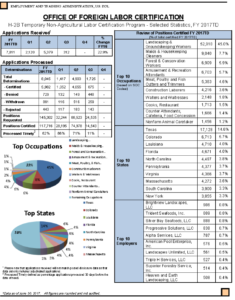The temporary, non-immigrant H-2B visa program was created as part of the Immigration Reform and Control Act of 1986. The H-2B program permits employers to bring in foreigners after proving that they cannot find a sufficient number of U.S. workers to perform temporary, nonagricultural services or labor on a one-time, seasonal, or peak load basis.
A cap of 66,000 visas was set in 1990 as part of an agreement crafted by Senator Ted Kennedy. Despite the fact that GDP has tripled since 1990, the cap has remained at 66,000.
The temporary/non-immigrant programs have become increasingly important to employers in seasonal industries that have difficulty in recruiting and hiring legal, seasonal labor. Landscapers are the largest user of the H-2B program followed by hospitality, reforestation, and outdoor amusement (carnivals and fairs) industries. The average employer employs fewer than 20 H-2B workers; many employ five or less.

For most H-2B employers, H-2B workers are supplementary to their principal workforce which is made up of US workers, even in the seasonal/temporary jobs.

* Not all H2B jobs are on Indeed and Monster.com. Usually job postings are on one or the other.
